Everyone should have the opportunity to feel the joy and freedom of riding a bike. And for people with disabilities, this was not possible until the invention of the adaptive bicycle.
What is an adaptive bike? It’s a bike designed specifically for people with disabilities. Adaptive bikes are designed to accommodate each rider’s specific needs and physical abilities.
There is no one-design-fits-all for adaptive bikes. Some adaptive bikes are designed for daily outings, while others are designed for high-speed racing. Adaptive bikes have many different design variations from wheels, seating, to how the bike is propelled.
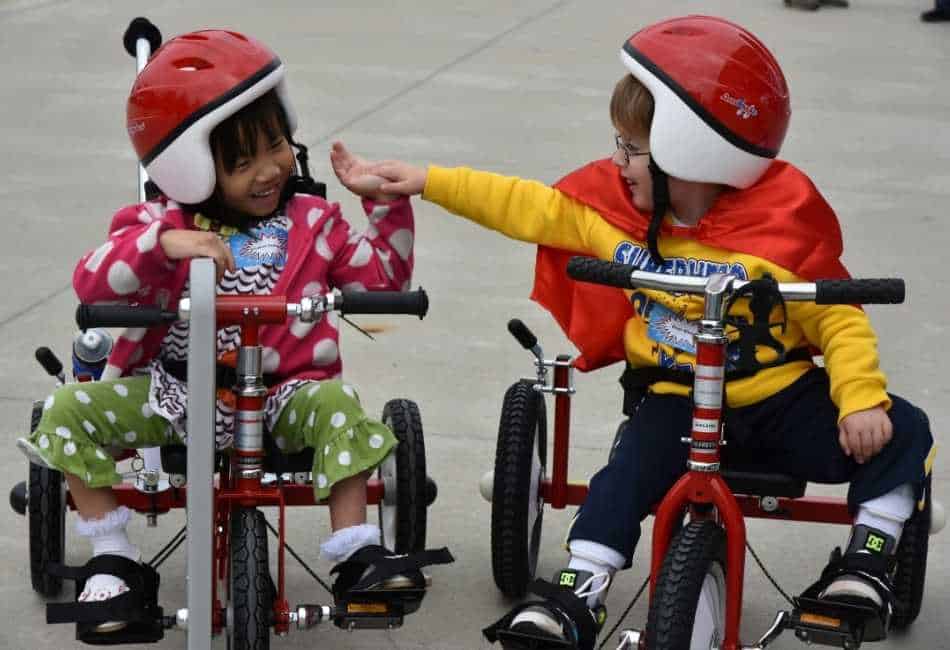
Who Needs An Adaptive Bike?
Adaptive bikes are designed specifically for people with disabilities. You can find adaptive bikes for people from 18 months old into adulthood. Adaptive bikes have helped people with physical, visual, intellectual and learning disabilities. Some of these disabilities include Autism, Cerebral Palsy, Down Syndrome, and Spina Bifida. Veterans and people with spinal cord injuries also benefit from using adaptive bicycles.
Types of Adaptive Bikes
There are three main components that make up different variations of an adaptive bike including:
- How the bike is propelled
- The wheel quantity and configuration
- The seating system
There are three main ways to propel an adaptive bike:
- Hand and foot
- Foot
- Hand
There are five main types of configurations:
- Delta Tricycles
- Tadpole Tricycles
- Tandem Bikes
There is a wide variety of seating options for adaptive bikes depending on the rider’s needs. These are the two most common seats on the market:
- Recumbent
- Upright
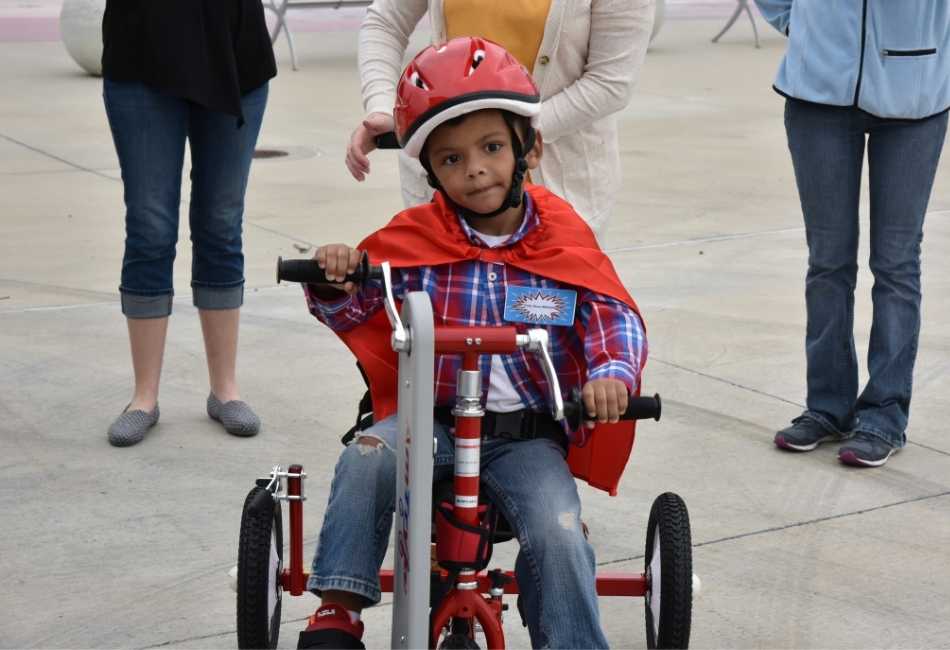
Hand and Foot Propelled Adaptive Tricycles
Hand and foot propelled adaptive tricycles are great for users looking to improve coordination, strengthen their muscles and increase endurance. This bike design is especially great for kids who have lower muscle tone, such as kids with Down Syndrome.
Foot Propelled Tricycles
Foot propelled tricycles are the most common adaptive bike. What sets these bikes apart from traditional models? Traditional tricycles do not provide the support and balance that many people with disabilities need. For those with conditions with low muscle control and limited head support, they require supportive seating with safety straps. And if users have limited control of their lower extremities, they may need foot straps to secure their feet to the pedals.
Additionally, many foot propelled adaptive Tricycles offer rear-steering with hand brakes for caregivers.
Hand Propelled Tricycles
Hand Propelled Bikes (a.k.a Hand Cycles) are used by people without the use (or have limited use) of their lower extremities. These bikes are often designed with wheelchair users in mind, making it easier to transfer from a wheelchair to the bike. Not only do hand propelled bikes help people gain independence, some models are also designed for racing.
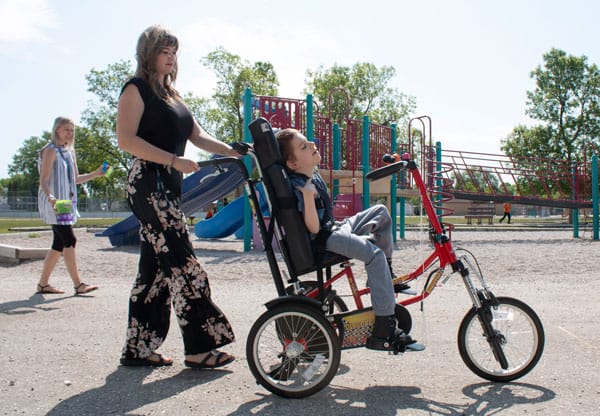
Delta Tricycles
Delta tricycles have one wheel in front and two in back. This is the most common tricycle configuration for adaptive tricycles. It is much easier to transfer from a wheelchair to a Delta trike in comparison to a tadpole trike. In general, Delta trikes are more practical for daily outings with it’s easy maneuverability. The main disadvantage to Delta trikes is they are not as fast as Tadpole tricycles, so it is not good for racing.
Tadpole Tricycles
Tadpole tricycles have one wheel in back and two in front. This configuration is popular for athletic riders. It’s fast, lightweight, and stable, making it a perfect choice for long distance riders. It sits lower to the ground, which can make it challenging to transfer is you (or your child) have low mobility.
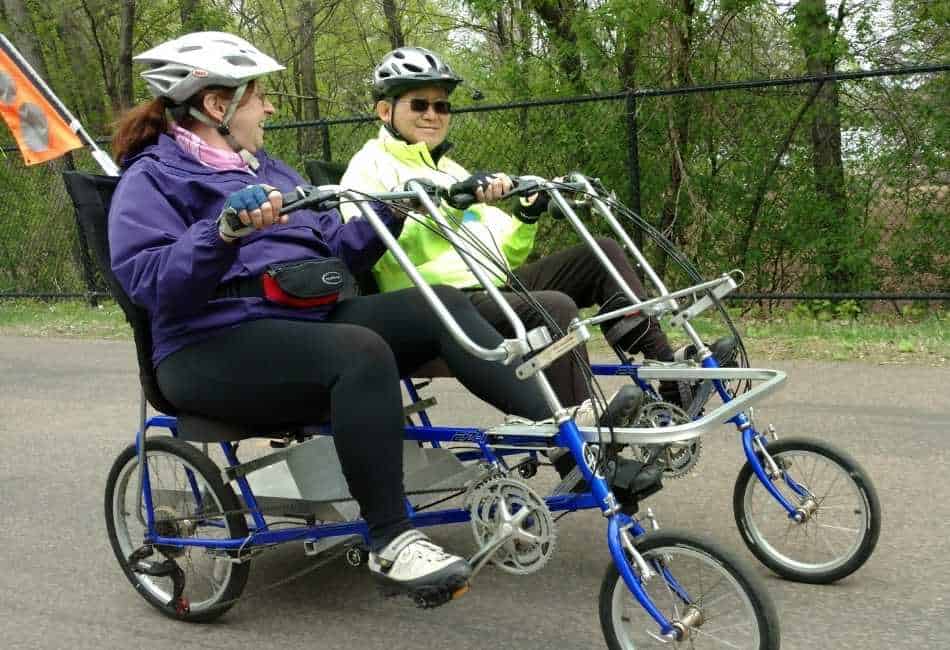
Tandem Bikes
Tandem bikes are perfect for people with disabilities who want the social aspect of riding a bike and need extra assistance. They are often ridden by those with visual impairments and others needing assistance pedaling.
With tandem bikes, caregivers ride with their loved one to ensure their fun and safety. The person with a disability can pedal for as long as they like, and when they get tired, the caregiver can take over. Some configurations offer side-by-side seating, while others have one rider in front, and the other in back. Depending on which bike model you buy, Tandem bikes can have 2, 3, or 4 wheels.
Recumbent Bikes
Adaptive recumbent bikes offer a large comfortable seat, backrest, and pedals on the front of the body to make it a smooth and comfortable experience. These bikes are especially great for those with poor trunk support.
Upright Bikes
With upright bikes, the pedals are positioned under the body so the rider’s center of gravity is more directly over the pedals. According to Freedom Concepts, their upright bike offers the proper hip-to-foot positioning and strengthening of anti-gravity muscles. These bikes are often used in therapy.
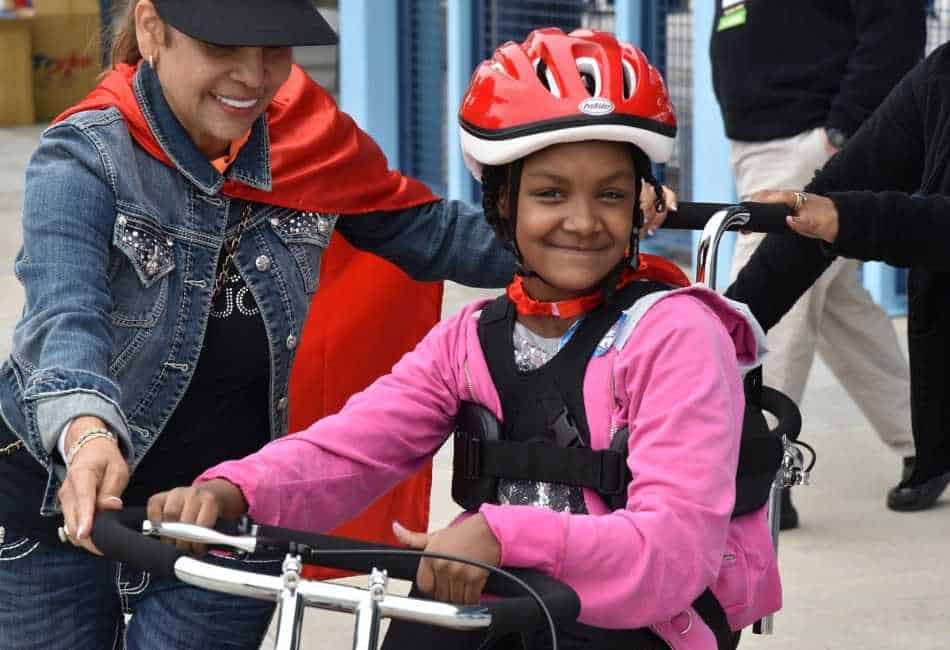
How Much Does An Adaptive Bike Cost?
An adaptive bike can cost anywhere between $519 – $9400. The average starting price for an adaptive tricycle is $3633. Below, we break down how we found the average price for an adaptive bike.
Since there is no one-design-fits-all for adaptive bikes, finding an accurate price range for a bike is challenging. Some riders require customizations that other riders don’t need. And while pricing for an adaptive trike is highly subjective, we used the following websites to find the starting prices of adaptive trikes.
Amtryke has five main tricycle models ranging from $519 – $1,299. The lowest priced bike is the 50- – 1410 model, designed for kids in the early development stages. And the most expensive model is the 50-HFC-0610 – AM-20, designed for teens and adults. The average starting cost of an Amtryke is $889. You can check out their trike models on their online store here.
When doing research on Freedom Concept’s website, we couldn’t find their starting price for their adaptive bikes. Since Freedom Concepts focus on customizing their products specifically to their customers, they do not list the prices on their website.
However, according to Adaptive Mall, Freedom Concepts offers bikes ranging from $2,416.50 – $5,606.10. The lowest priced tricycle was the Discovery Mini, designed for kids between 18 months and 5 years old. The most expensive bike listed on Adaptive Mall was the Excursion Tandem. The average starting cost of a Freedom Concept bike is $3,734.70.
Rad Innovations offers recumbent trikes and tandems ranging between $2440 – $9400. It is important to mention that a few of these models have electric motors. The company’s Hase Trigo 24-Speed is the most affordable option. And the The BerkelBike Pro Shimano 11-Speed is priced the highest. The average starting cost of a Freedom Concept bike is $6,366.
Based on the information above, we gathered the total averages to create the average starting price of $3633 for an adaptive tricycle.
Many families find that they can’t afford to buy an adaptive bike without financial assistance.
There are a few ways to get an adaptive bike for reduced prices, and even for free. Be sure to check out our resource page where we share how to get an adaptive bike.
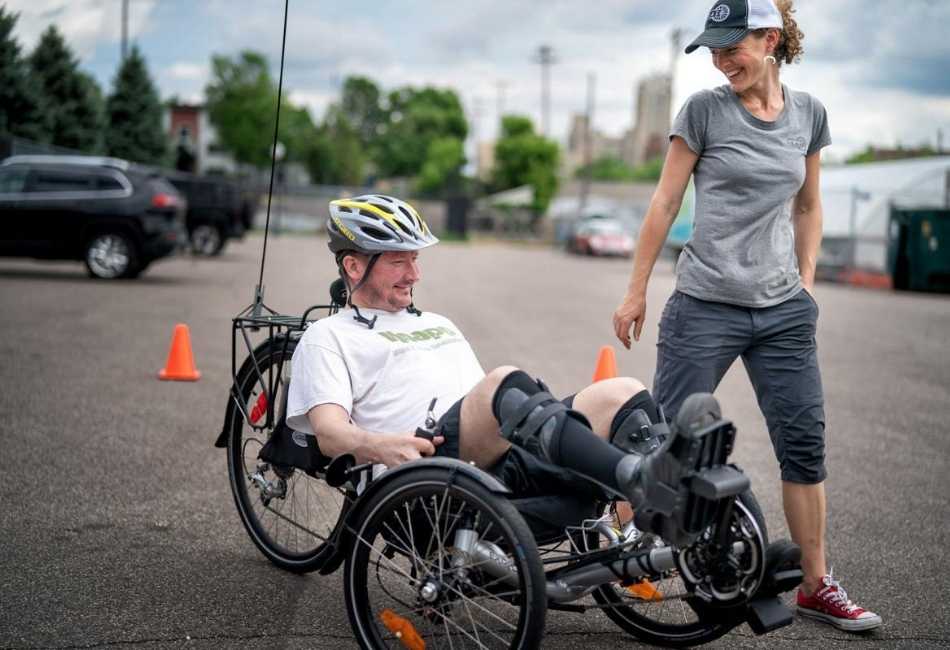
Will Insurance Cover An Adaptive Bike?
We asked a group of parents of kids with disabilities if insurance will cover an adaptive bike. Most of the time, parents shared that insurance didn’t cover the cost. Instead, many parents received a donated bike. AMBUCS, the company behind Amtryke bikes, has a “Wish List” program that works to donate adaptive tricycles to families who need financial assistance.
Do You Need A Prescription For An Adaptive Bike?
Prescriptions are not required for obtaining an adaptive bike. However, if you want insurance to help cover the cost, you will likely have to create a ‘Letter of Medical Justification’. This purpose of the letter is to inform the insurance provider of what disability your child has, and how the bike will help them.
Thankfully, you do not have to come up with a letter on your own. Adaptive bike companies such as Freedom Concepts provide families with example letters, along with steps about how to step through the submission process.
While many families share that their letters were rejected on multiple occasions, it was still worth advocating for their child to get them the care and freedom they need. If you would like to learn more about how to submit a letter of medical justification, be sure to read this article from Freedom Concepts.
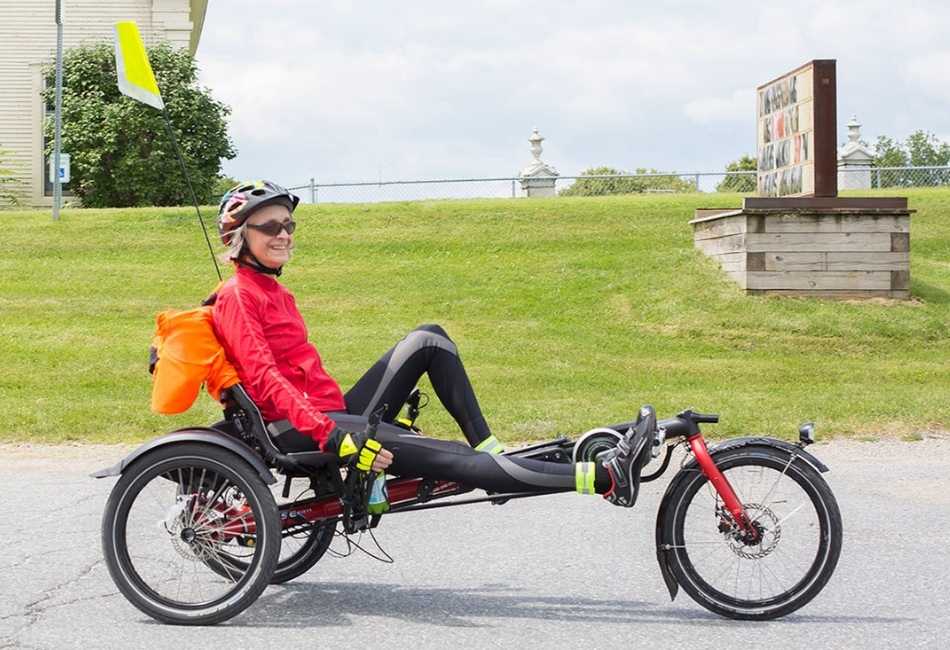
Tips for Choosing An Adaptive Bike
If you have a child with disabilities, be sure to involve them in the process as much as possible. If your child has muscular issues, it’s important to have them test a bike before buying it. Some bike models are designed to help people with low muscle tone, while others support riders with tight muscles. If your child works with a therapist, talk with them about the possibility of testing bike models.
Before buying an adaptive bike, ask yourself the following questions:
- Does my child struggle with balance? If so, it may be best to buy a delta tricycle.
- Can my child sit upright independently? If not, it may be best to look into recumbent bikes with a 4-point harness, adjustable tilt, and head support.
- Can my child work their upper and/or lower extremities? If your child has limited use of the lower extremities, a hand propelled bike may work best. However, if you and your child’s therapists want to work to improve their muscle tone, having a hand and foot propelled bike may work best. And if your child struggles with coordinating both upper and lower extremities, a tandem bike may be your best bet. Again, talk with your child’s therapist for further guidance.
- What is the terrain? If your child plans on riding down paved roads and sidewalks, then having bikes with standard wheels work great.
Final Thoughts
Adaptive bikes have been a huge game-changer for people with disabilities. Not only are adaptive bikes fun to ride, it is therapeutic and helps to increase disability inclusion.
Choosing the right bike can be challenging when there are so many considerations. If you would like to narrow down your options to the best family-approved brands, check out our guide where we share the top three best adaptive bikes.
